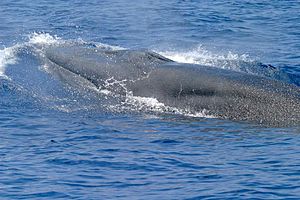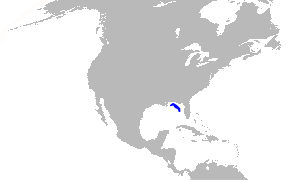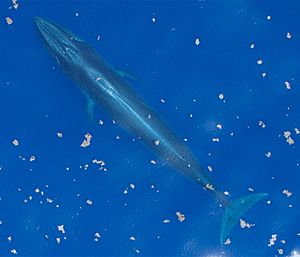Rice's whale facts for kids
Quick facts for kids Rice's whale |
|
|---|---|
 |
|
| Rice's whale in the Gulf of Mexico | |
 |
|
| Size compared to an average human | |
| Conservation status | |
| Scientific classification | |
| Genus: |
Balaenoptera
|
| Species: |
ricei
|
 |
|
| Core range as of June 2019 | |
| Synonyms | |
|
|
The Rice's whale (Balaenoptera ricei) is a special type of baleen whale. It lives only in the northeastern Gulf of Mexico. For a long time, people thought it was a type of Bryde's whale. They called it the Gulf of Mexico Bryde's whale.
Scientists first thought it was a different species in 2014. They looked at its DNA (the genetic material that makes every living thing unique). More studies in 2021 confirmed it was indeed a new species. The whale is named after Dale W. Rice, a scientist who studied whales.
Contents
About Rice's Whales
Rice's whales are medium-sized whales. They can grow up to about 12.65 meters (41.5 feet) long. That's about the length of a school bus! They can weigh around 13.87 metric tons (about 30,000 pounds).
These whales are long and thin. They have 44 to 54 grooves on their belly. They also have 230 to 288 pairs of baleen plates. These plates are like giant combs in their mouths. They use them to filter small food from the water. Their flippers are short and narrow, up to 1.65 meters (5.4 feet) long. Their dorsal fin (the fin on their back) stands upright. It can be up to 37.8 centimeters (14.9 inches) tall. Their tail fins, called flukes, are smooth and wide. They can be up to 3.16 meters (10.4 feet) across.
Scientists don't know much about what Rice's whales eat or how they behave. They often guess based on what they know about Bryde's whales. Rice's whales are usually seen alone or in pairs. Sometimes, they form larger groups to find food. During the day, they dive deep to hunt, sometimes as deep as 271 meters (889 feet). At night, they usually stay closer to the surface, within 15 meters (49 feet).
Where Rice's Whales Live
Some scientists think Rice's whales once lived all over the Gulf of Mexico. Today, they are only seen in a small part of the northeastern gulf. This area has a continental shelf that is 100 to 400 meters (328 to 1,312 feet) deep. They stay in this area all year long.
It's possible that some Rice's whales live near Cuba and Mexico. However, the only known group lives in US waters. There are fewer than 100 of these whales left. Rice's whales are the only baleen whales that live in the Gulf of Mexico all the time. Other whale species in the area just pass through.
Whale Family Tree
Scientists use phylogeny (the study of how living things are related) to understand whale families. The chart below shows how Rice's whale is related to other whales. It's based on genetic information.
| Mysticeti |
|
||||||||||||||||||||||||||||||||||||||||||||||||||||||
How Rice's Whales Were Discovered
Whalers first wrote about whales in the Gulf of Mexico in 1790. But it wasn't until the 1990s that people noticed how few of these whales were left. In 2014, a genetic study suggested that Rice's whale might be a separate species.
It was hard to study the species properly because scientists didn't have a good whale specimen. Then, in early 2018, a dead whale washed ashore in Everglades National Park in Florida. This whale was taken to the Smithsonian Institution. This gave scientists a chance to study the whale closely. They could confirm it was a distinct species without harming any living whales.
Protecting Rice's Whales

Before it was officially named, the Rice's whale was called the "Gulf of Mexico whale." It is listed as critically endangered. This means it is at a very high risk of becoming extinct. The United States also lists it as an endangered species under the Endangered Species Act.
There are fewer than 100 Rice's whales left. Only about 17 of them are old enough to have babies. This makes them one of the most endangered types of whales. While some whales were hunted in the 1700s and 1800s, hunting is not thought to be the main reason for their low numbers today.
A big problem for Rice's whales was the 2010 Deepwater Horizon oil spill. A study found that almost half (48%) of these whales were exposed to the oil. About 18% of them got sick. Some females (22%) could not have babies after the spill. This oil spill caused the Rice's whale population to drop by about 22%.
Other dangers to Rice's whales include ships hitting them. Also, noise from human activities underwater can harm them.
Images for kids
-
Lanternfish (shown) and hatchetfish are possible prey of the Rice's whale.
See also
 In Spanish: Rorcual de Rice para niños
In Spanish: Rorcual de Rice para niños







